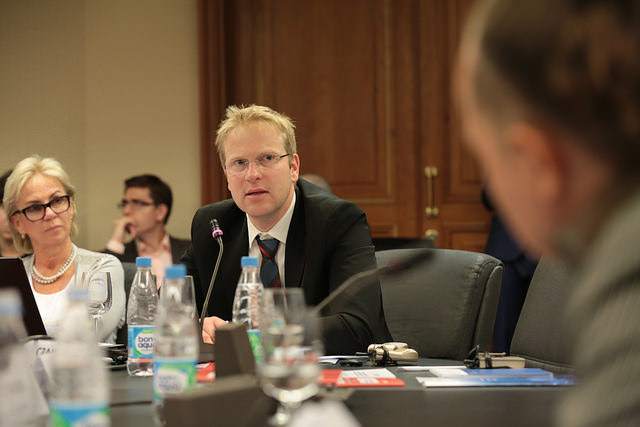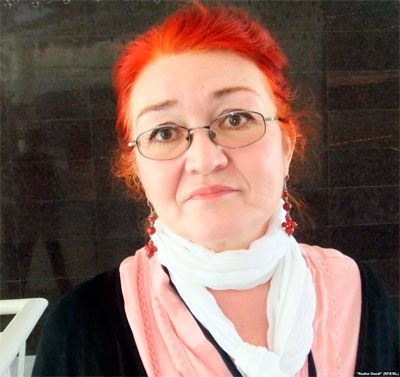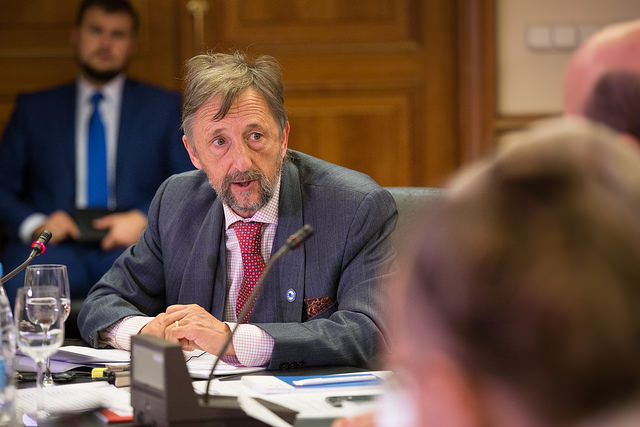Migration – A Challenge of Time
In
Login if you are already registered
(no votes) |
(0 votes) |
Leading figures in migration research shared their expert opinions on the subject and the prospects for its development: Mathias Czaika, Senior Research Officer at the International Migration Institute, Oxford University; Marta Jaroszewicz, Senior Fellow at the Centre for Eastern Studies in Poland; Saodat Olimova, Director of the SHARQ Research Centre in Dushanbe, Tajikistan; and Patrick Taran, President of Global Migration Policy Associates.
On September 24–25, 2015, the Russian International Affairs Council (RIAC) and the Russian Presidential Academy of National Economy and Public Administration (RANEPA) held an international conference on the problems of migration in the modern world. At the conference, Russian and international experts discussed the numerous aspects of migration and the impact it has on governments. Particular attention was paid to the ongoing migrant crisis in the European Union.
Leading figures in migration research shared their expert opinions on the subject and the prospects for its development: Mathias Czaika, Senior Research Officer at the International Migration Institute, Oxford University; Marta Jaroszewicz, Senior Fellow at the Centre for Eastern Studies in Poland; Saodat Olimova, Director of the SHARQ Research Centre in Dushanbe, Tajikistan; and Patrick Taran, President of Global Migration Policy Associates.
How does the UK see the current migration crisis in Europe?
Mathias Czaika: The British response reflects the government’s general and basic views on migration. It fits well into their medium-to-long-term goal of bringing net migration down to a level below 100,000 which was made explicit in 2009 when the conservative liberal government came into place. So this is generally seen as a target that the government is aiming to achieve in terms of net immigration. A lot of measures have been taken to make that happen: more restrictive policies on students and other entry categories have been significantly revised. However, a significant group of immigrants which is basically the European migrants, are not controllable. There’s free mobility into the UK of European citizens. So right now in 2014-2015 we’re still at the level of about 300,000, beyond the actual target. I think the fact that the government is rather reluctant in cooperating on the matter of refugees and asylum seekers fits into that broader policy aim and migration policy agenda that the British government has, and so it doesn’t come as a surprise that the government has a rather restrictive policy.
Do you think that current refugee crisis will have influence, well, negative or positive, on the economic welfare in the EU?
Mathias Czaika: Let’s start with basic facts. This year we have seen an inflow of a million refugees and asylum seekers in the European Union which is less than one per cent of the of Europe’s population which is about 500 million. How much of an effect can have an inflow of 0.2 per cent on the general economic welfare? In aggregate terms the effect is rather limited. Nevertheless, of course, there are winners and losers. First of all, the countries that host more of those incoming migrants, like Germany, Hungary, Sweden, and Austria receive a large share of one million. In particular Germany, which expects about three hundred thousand in 2015. Other countries are far less affected by the inflow. For Germany and aforementioned countries it depends on the relative number. For Sweden the relative number is high. For Austria and Germany it’s about European average in relative terms to the population. It’s a kind of matter of putting numbers into perspective. When we’re looking more in detail on who is affected in economic terms the hypotheses we get from economic is theories that it is those who directly compete with the incoming labor. The first question is incoming migrants’ access to the labor market.
The fact that the government is rather reluctant in cooperating on the matter of refugees and asylum seekers fits into that broader policy aim and migration policy agenda that the British government has, and so it doesn’t come as a surprise that the government has a rather restrictive policy.
The next question: how quickly and to what extent do asylum seekers and refugees get access to the labor market? If they get access to the labor market then the subsequent question is how quickly can they integrate into the labor market and how quickly do they fill vacant jobs? And then if they get access to the labor market and actually find jobs, then the question is who are they competing with? What history shows is that it is mostly earlier migrants or past migrants who manage to get jobs. Their wages might be at least depressed to some extent. Other groups of native workers depend a lot on the extent to which new migrants actually are complimentary to the local domestic labor force. The effect on the native population and native workers is very limited. It’s either neutral or even slightly positive. It’s relatively minor in terms of economic effects on indicators like wages and employment. When it comes to the public finances it depends a lot on the extent to which new migrants can be integrated into the labor market and how quickly they can become taxpayers. This is about the matter of making today refugees future taxpayers – those who will financially insure aging societies in Western Europe. To some extent this is a political question. How fast can migrants acquire necessary skills and learn languages? It depends a lot on the absorption capacity of domestic labor markets, and this absorption capacity depends again on how much we are ready to invest into the skills of these new workers.
Lately in press there’s been a lot of talk that this recent influx of refugees could break the European Union from inside. What do you think about it?
Mathias Czaika: I think there’s a lot of speculation going on right now. Currently we are witnessing a political crisis which is caused by the refugee situation in the Middle East, and now in the European Union. This political crisis shows that European societies and governments haven’t yet been able to develop a concept of values and understandings in various political fields. There’s no political union as in other fields like the Europe crisis. The role of national states is still important, and there’s a conflict of interests. We have a very heterogeneous group of countries, and this heterogeneity has all increased with the recent enlargements in 2000s with these European countries. It becomes increasingly more difficult to find common sense in certain issues. This is a critical point in recent European history. Our political leaders will be able to lead the societies into a new era of common understanding of European values, and I think it’s only a speculation on how this process will end. But I hope that the European Union will become stronger. It’s a very challenging period of time, and policy makers are pushed by the crisis. Sometimes crises also bring up new opportunities, and I think that this will be the case here. It might increase the integration of the European Union.
What does Poland expect from the influx of migrants from the Middle East?
Marta Jaroszewicz: So far, Poland had agreed to take in around 7,000 refugees from the Middle East and North Africa. The number could rise to 12,000. It all depends on the joint decision of the European Union, taking the dynamics of the crisis and its development into account. But I don’t see any significant changes taking place.
Considering the fact that this is the first time that migrants from the Middle East have sought refuge in Poland, new integration mechanisms may be set up in response to the current situation. If this happens, we will see more detailed changes being made to the integration policy of the Polish leadership. Before the crisis, there was never any need to resort to long-term integration tools, as migrants generally came from other European countries or from countries that are similar to Eastern European countries in terms of language and culture. Poland has never had a rigorous and detailed integration policy.
What is the stance of the Polish authorities with regard to Europe’s migrant policy?
This is about the matter of making today refugees future taxpayers – those who will financially insure aging societies in Western Europe.
Marta Jaroszewicz: The European Union did not have a common migration policy until this crisis. All we have are internal European norms that need to be observed. Each country has its own interests and its own take on the matter. Poland emphasises solidarity with those countries that are more susceptible to the consequences, but the situation is changing on a weekly basis. It is important for Poland to uphold the voluntary principle, which does not envisage the introduction of tools for the automatic distribution of refugees. Another key point is the issue of creating an effective mechanism for distinguishing refugees from economic migrants.
What is the current migration situation in Poland?
Marta Jaroszewicz: There was a significant outflow of Polish citizens from the country after it became part of the European Union and the labour markets of other European countries opened up in 2004. Around two million people left the country. This is a big problem for Poland in terms of demographics, but it could also be a blessing, as those who left the country were often unemployed or their skills were not in demand at home. It was mostly people from small towns with significant structural problems. In any case, we do not want the trend of people leaving the country to continue. This is because in ten years Poland, where the average age of the population is significantly lower than in the European Union as a whole, will begin to see the problems that are now affecting other EU countries.
Poland became an attractive country for migrants in 2009–2009 thanks to its annual economic growth rate of 3 per cent and the fact that it remained unaffected by the financial crisis. This had previously been the case in Italy and the Czech Republic. The flow of migrants into the country intensified following the outbreak of the crisis in Ukraine. Around half a million Ukrainian migrants are currently living in Poland, which represents 90 per cent of all migrants in the country. The remaining 10 per cent is made up of Belarusians and natives of the Northern Caucasus.
Has the reduced number of money transfers had an effect on social stability in Tajikistan?
Saodat Olimova: Of course it has. In some ways, it is reminiscent of what was happening during the crisis in 2008. What is the same? Well, just like last time, the lag between the recession in Russia and recession in Tajikistan is about three or four months. So we started to feel the squeeze in April.
A distinguishing feature of this crisis is the currency fluctuations, which have had several consequences. First of all, there is the reverse flow of money into Russia, primarily in the form of dollar transfers. Starting in December, and for a period of three to four months, the reverse flow of money transfers to Russia was extremely high. This caused confusion in the part of the financial services sector that kept an eye on the balance of payments, which showed a 9 per cent decline in money transfers at the end of 2014. In reality, the situation was different. Migrants were buying consumer goods in Russia and taking them to Tajikistan, where they would sell them off for dollars. They would then send the money back to Russia. Nobody had a clue what was happening with the transfer system or what was happening with the exchange rate: money transfers strongly affect the balance of payments in Tajikistan.
The situation was only stabilized in May, but by then there were new consequences. The sharp decline in the exchange rate helped Russia squeeze China out of the consumer market in Tajikistan. Russia supplanted China as our main partner during the first two quarters of 2015.
It used to be that you would earn your money in Russia and spend it on Chinese goods. Now the money is going back to Russia in the form of dollar transfers.
The citizens of Tajikistan are getting poorer. The number of people considered to be “poor” has risen dramatically, and increasing numbers of young people are being sent to Russia for work. Just how long this trend will continue nobody knows.
How do you see the migration situation developing in Tajikistan?
Saodat Olimova: Crises don’t last forever. But there is no quick exit from the current situation. I believe that the number of people emigrating to Russia will increase. It’s impossible to emigrate to China, because they have demographic issues of their own. Uzbekistan is in the same position as Tajikistan. There is only one border territory with relatively unoccupied and uncultivated land – where there are jobs. Whatever happens, there will always be jobs in Russia. In fact, by 2025 there will be a serious shortage of workers. And whatever laws might be adopted, there will always be jobs for Tajiks who are ready to work.
How do you estimate the ongoing massive displacement of people in Europe? Is it going to affect the whole socio-cultural situation in European countries?
Patrick Taran: The annual arrivals of immigrants to the 28 countries of the European Union are approximately 3.6 million. Departures represent about 2.8 million per year, meaning that the net immigration to Europe is around 800,000. But if we look at the current arrivals, primarily of refugees coming from Syria and other countries in the Middle East, the actual proportion borders a quarter of the total annual arrivals to the European Union. In 1992 the total number of asylum seekers or refugees who reached Europe was around 670,000. And if they were asylum seekers that meant that they were arriving in irregular or temporary situations. Some of the predictions of the total number of people who may reach the EU this year might be a bit exaggerated. We’re not seeing a situation so different in volume from what it has been on several occasions. For instance, in 1968 more than 200,000 Czechoslovakians arrived in Austria in just a matter of weeks. Going back a bit further, in 1956 around 200,000 Hungarians fled the uprising and the Soviet occupation.
So can we say that the situation is much more exaggerated than it actually is?
Patrick Taran: One cannot say that it’s exaggeration to call the ongoing situation a crisis but in terms of members, in terms of proportion, it’s not exactly either unprecedented or necessarily overwhelming for the European Union. The underlying comment I would make though is that the number of refugees coming to Europe is predictable: look at half of the entire population of Syria now being displaced internally or externally. Turkey, for example, already has two million Syrians, and Lebanon - about million and a half. We’re talking about single countries with two, three, four times the number of people who arrived in the entire European Union, albeit a little bit more suddenly.
A lot of analysts have been talking about the concept of nation state being in process of dying due to these waves of migration. Can you agree with this statement?
Patrick Taran: I’m just wondering what planet they’re on because I haven’t seen any evidence of weakening of nation states or the disappearance of the European cultures. And to say that thirty thousand people in countries of six or ten million are going to change culture because they happen to arrive in a short period of time suggests either an outlandish understanding of what culture is and the situation people are arriving in, or it suggests people are extremely insecure about their own traditions even when they have existed for five hundred years.
Can migration flows seriously affect the economic well-being of European countries? Is the EU trying to shift attention from real economic problems to the migration issues?
Patrick Taran: Perhaps the way it’s described is a distraction. The reality is the opposite. And I think it was no accident that Germany welcomed a large number of refugees because in the next fifteen years the German labor market will shrink by five million people. The people coming are reasonably well-educated and can easily be accommodated. It will solve a major problem that Germany has, which is not necessarily employment/unemployment but the lack of people power it needs to continue sustaining an economy.
And was this wave of migration a predictable development?
Patrick Taran: European countries knew that people would be displaced. They could even guess the numbers but they said if they had publicly prepared themselves it would have been politically inconvenient. They could not say “We’re expecting this” because then it would be perceived either as a self-fulfilling prophecy or further support to the continuation of the war effort; an investment of Europe in selling arms to Middle Eastern countries and intervening now directly with air bombardment. I don’t think there was an expectation two or three years ago that the entire country of Syria would be so devastatingly destroyed in sort of warfare, and where in a very short period of time half of the country’s entire population would be displaced. That’s almost unprecedented. Current situation is no big surprise except maybe on the larger scale.
How is the situation going to develop in the future?
Patrick Taran: Well, unfortunately, all parties involved in or with interest in Syria, including the Russian Federation, are still providing arms and military support. Other countries, Europe and the West are providing direct military intervention as well as arms. All of the visible policymakers continue to advocate for a military solution. Ultimately, political conflict can only be resolved with a political solution. We can continue to pursue military goals but it will force the rest of Syrians to leave their homes and cross borders to places where they may have some shelter from the bombs and the troops.
Prepared by Elena Alekseenkova, RIAC program manager, Mariya Smekalova, RIAC web editor, and Maria Gurova, RIAC web editor
(no votes) |
(0 votes) |







